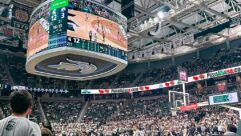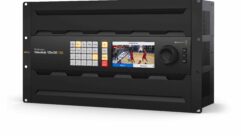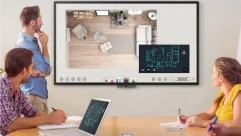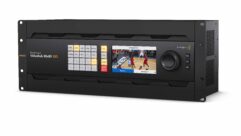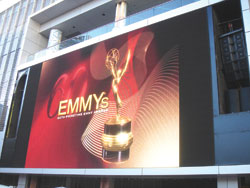

L.A. Live’s Massive AV Install
Keeping consumers in one place in a competitive entertainment market like Los Angeles, not to mention revitalizing the city’s long-neglected downtown area, has required ambition and deep pockets. Over the past 10 years, billionaire developer Philip Anschutz has shown both in his efforts to bring people back to the heart of the city.
CHALLENGE: Create an AV and data distribution system for a sprawling entertainment complex and design it so the system can be easily accessed from virtually any location.A Multipurpose Outdoor VenueIndeed, multiple systems–everything from the Nokia Theatre sound system to telecommunications to broadcast support to closed-circuit security cameras–are wired into a vast web of cabling.
Broadcasting to Nokia Plaza, the Nokia Theater’s 42- by 28-foot Mitsubishi LED display is flanked by two line-arrays consisting of JBL three-way elements and JBL 18-inch, 2,400-watt subwoofers driven by Crown amps.
Credit: Courtesy IPR Services
SOLUTION: Map out and ID every other foot of cabling to speed up installation and allow users to patch into the system quickly and efficiently.
Keeping consumers in one place in a competitive entertainment market like Los Angeles, not to mention revitalizing the city’s long-neglected downtown area, has required ambition and deep pockets. Over the past 10 years, billionaire developer Philip Anschutz has shown both in his efforts to bring people back to the heart of the city. Nearly a decade ago, his Anschutz Entertainment Group (AEG) led the financing and construction of the $375 million Staples Center, a building that attracted big-time concerts, basketball’s Los Angeles Lakers (and–if you’re one who still cares–pro hoops’ Clippers), and pro hockey’s L.A. Kings to a downtown area that had degenerated in decades prior into a virtual ghost town during evening hours.
And AEG didn’t stop after Staples opened in 1999. The company is currently leading a $2.5 billion construction project to create a massive, interconnected, two- by six-block multipurpose entertainment and living destination right across 11th Street from the Staples Center and the Los Angeles Convention Center.
Rolling out in stages, this new L.A. Live complex will ultimately include 5.6 million square feet of apartments, bars, theaters, and restaurants. It will also feature a 54-story Ritz-Carlton Hotel tower.
Last December, the 40,000-square-foot Nokia Plaza–the gateway to this all-encompassing destination–opened for business. It’s a multimedia-rich outdoor hub designed to look like Times Square in New York.
The roughly rectangular-shaped area (see “Site Plan,” page 30) is the central, open-air meeting place for the entire L.A. Live campus, leading almost directly out of Staples, straight into the new 7,100-seat Nokia Theatre concert venue, and abutted by the soon-to-open “Building A” dining and club complex and ESPN’s new West Coast broadcast center. As you might imagine, AV makes the Nokia Plaza dazzle.
From the six AV towers with LED boards and loudspeakers to displays hanging from the Staples Center and other buildings (top) to the JBL line arrays surrounding the Nokia Theatre’s display (left), audio and video command the attention of visitors to Nokia Plaza.
Credit: Courtesy IPR Services
Designed to host everything from community festivals to live broadcast concerts simulcast from inside the Nokia Theatre, the plaza actually had its unofficial debut last September. On Sept. 21, it played host to red carpet festivities for the 60th Annual Emmy Awards, which took place in the Nokia Theatre.
Broadcasters from around the world were able to hook into the theater’s video feed at myriad fiber-optic patch points located within both the plaza and the theater. Meanwhile, media members and celebrities milling around the Nokia Plaza were able to watch a live feed of the awards show on the more than 20,000 square feet of Mitsubishi Electric-made 20 millimeter LED screens festooned all over the plaza. The displays include a 42- by 28-foot screen mounted on the front of the Nokia Theatre, as well as LED boards on six surrounding AV towers. (Last month, AEG said it planned to install a 8,000-square-foot Panasonic display on the side of complex’s hotel tower.)
Lined three to a side and about 40 feet apart, the AV towers create a corridor through the heart of the plaza. Three of the towers’ four sides are lined, about half-way up, with identical Mitsubishi 20- by 10-foot LED boards, each mounted at equal height. Further up the towers, past the various lighting elements and advertising signage to the very top of each structure, sit four Crown CTs 3000 amps drive speaker clusters that include four JBL AM6315/95 loudspeakers.
The large LED screen on the side of the Nokia Theatre has its own sound support, augmented by line-arrays on either side, each consisting of five JBL Vertec 4888 three-way elements and two JBL ASB-6128 18-inch, 2,400-watt subwoofers. For each of these line arrays, six Crown I-Tech 6000 amps drive the 4888s, while a single Crown I-Tech 8000 powers the subwoofers. The equipment is stored in an air-conditioned recess behind the mammoth Mitsubishi LED board, along with several Soundweb London Blu80 DSP processors.
All of the plaza’s video displays and audio systems are programmed and controlled via a room below the plaza adjacent to the parking structure. AEG operators use Soundcraft Vi6-Optical digital production room consoles to set the scene for the various different events taking place in Nokia Plaza.
The sound system can be configured in a number of different modes. Concert mode, for example, is a broader audio distribution scheme designed to fill the whole plaza with sound. It calls for the tower-mounted JBL loudspeakers, angled southward toward the street, to act as delays.
Equipment List
Following is a sampling of the gear IPR Services and others integrated for the Nokia Plaza in Los Angeles.
- 24 Crown CTs 3000 amps (towers)
- 12 Crown IT6000 amps for VT4888
- 2 Crown IT8000 amps for subwoofers
- 2 Hewlett-Packard 2626 Ethernet switches (control and CobraNet)
- 24 JBL AM6315/95s speakers (towers)
- 10 JBL VT4888 plaza arrays
- 2 JBL VT4888-AF array frames
- 4 JBL ASB6128 plaza subwoofers
- Mitsubishi Electric custom 20 mm LED displays
- Sony IXS-6700 router mainframe
- Sony MVE-8000A Multiformat MVE processor
- Sony MVS-8000G Multiformat video switcher
- 1 Soundcraft Vi6-Optical digital production room console
- 3 Soundweb London BLU80 DSP processors
- 2 Soundweb London BLU32 DSP processors
— Source: IPR Services
Meanwhile, for smaller, more intimate functions, such as a recent presentation in the plaza of a Spike Lee film shot entirely with Nokia wireless phones, the north-facing tower clusters–those angled directly toward the master LED display on the Nokia Theatre–act as a kind of 5.1 surround-sound system, with the south-facing clusters turned off.
“It’s a pretty good sized space, 200 feet deep by 120 feet wide, so we just wanted to make sure we had enough power to cover it,” says Larry Spurgeon, the Las Vegas-based audio systems designer who was brought in to figure out the sound in both the Nokia Theatre and the Nokia Plaza.
“Not only is [the plaza] a large area, but we’re competing with a lot of other sound sources when you factor in all the restaurants and clubs in the area,” he adds.
Web of Cables
While designing a robust outdoor sound system that could overcome a large, noisy area wasn’t easy, integrating it and all the other AV systems into the broad multimedia vision of L.A. Live was equally challenging. And that task fell to Hacienda Heights, Calif.-based IPR Services, the master low-voltage contractor not only for L.A. Live, but for a host of other AEG projects around the world.
IPR’s solution called for a fiber-optic AV transmission and control network across the entire L.A. Live complex over which, for example, broadcast feeds from Lakers games could originate in the Staples Center production room and be shown in real time in the plaza.
Similarly, live audio and video from the classic rockers the Eagles, one of the Nokia Theatre’s first live acts, could also be played on the plaza AV system. Or alternatively, on a slow afternoon at L.A. Live, AEG system programmers operating in the bowels of the plaza’s control room could choose to run a promotional package showcasing upcoming L.A. Live events on every LED screen in the complex–not just on those mounted in and around the plaza, but also on displays lining the exterior of Staples Center across the street.
“The whole facility is heavily networked,” Spurgeon says. “It’s easy to get digital signals from one building to another. You can send virtually anything from anywhere.”
SITE PLAN: Nokia Plaza (in green) is just one part of the sprawling L.A. Live complex envisioned by Anschutz Entertainment Group. All the various systems are interconnected throughout. Video feeds from the nearby Staples Center can also be transmitted to locations like the plaza.
Credit: Courtesy IPR Services
To make it easy to patch into the systems from almost anywhere in and around L.A. Live, IPR devised a simple yet nifty categorization methodology. In the Nokia Theatre, for example, there are 30 panel-equipped locations from which operators can access the complex’s vast AV and IT systems.
The trick to making the system manageable: Each wire within the network of more than 2.5 million feet of cable (as thick as 112 wires at its most complex points) is labeled numerically every 2 feet. This ID number starts with digits signifying what system the cable belongs to, as well as those that designate the cable type and specific task.
“Because each of these wires is numbered throughout their length, it enabled us to identify them and terminate them that much quicker and significantly reduced the installation time,” says Robert Patrick, who managed the project for IPR Services.
“It’s a system we’ve developed over time, and we’ve used this same concept for [AEG] projects in London and Berlin already. The biggest challenge on a job like this is to manage and control all of the various systems and keep them in a coherent fashion from an operational point of view,” adds Patrick. “And the infrastructure and the connectivity is at the heart of making the entire campus work as a single coherent site.” And if that’s so, Nokia Plaza, the latest addition to the campus, is where the heart beats.
Daniel Frankel is a freelance writer and frequent contributor to Pro AV. He is based in Los Angeles.



